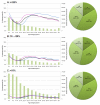The use of insecticide treated nets by age: implications for universal coverage in Africa
- PMID: 19796380
- PMCID: PMC2761895
- DOI: 10.1186/1471-2458-9-369
The use of insecticide treated nets by age: implications for universal coverage in Africa
Abstract
Background: The scaling of malaria control to achieve universal coverage requires a better understanding of the population sub-groups that are least protected and provide barriers to interrupted transmission. Here we examine the age pattern of use of insecticide treated nets (ITNs) in Africa in relation to biological vulnerabilities and the implications for future prospects for universal coverage.
Methods: Recent national household survey data for 18 malaria endemic countries in Africa were assembled to identify information on use of ITNs by age and sex. Age-structured medium variant projected population estimates for the mid-point year of the earliest and most recent national surveys were derived to compute the population by age protected by ITNs.
Results: All surveys were undertaken between 2005 and 2009, either as demographic health surveys (n = 12) or malaria indicator surveys (n = 6). Countries were categorized into three ITN use groups: <10%; 10 to <20%; and > or =20% and projected population estimates for the mid-point year of 2007 were computed. In general, the pattern of overall ITNs use with age was similar by country and across the three country groups with ITNs use initially high among children <5 years of age, sharply declining among the population aged 5-19 years, before rising again across the ages 20-44 years and finally decreasing gradually in older ages. For all groups of countries, the highest proportion of the population not protected by ITNs (38% - 42%) was among those aged 5-19 years.
Conclusion: In malaria-endemic Africa, school-aged children are the least protected with ITNs but represent the greatest reservoir of infections. With increasing school enrollment rates, school-delivery of ITNs should be considered as an approach to reach universal ITNs coverage and improve the likelihood of impacting upon parasite transmission.
Figures


Similar articles
-
Age and gender trends in insecticide-treated net use in sub-Saharan Africa: a multi-country analysis.Malar J. 2018 Nov 14;17(1):423. doi: 10.1186/s12936-018-2575-z. Malar J. 2018. PMID: 30428916 Free PMC article.
-
Evaluation of universal coverage of insecticide-treated nets in western Kenya: field surveys.Malar J. 2014 Sep 3;13:351. doi: 10.1186/1475-2875-13-351. Malar J. 2014. PMID: 25187326 Free PMC article.
-
Assessing whether universal coverage with insecticide-treated nets has been achieved: is the right indicator being used?Malar J. 2018 Oct 11;17(1):355. doi: 10.1186/s12936-018-2505-0. Malar J. 2018. PMID: 30305127 Free PMC article.
-
Estimating the number of insecticide-treated nets required by African households to reach continent-wide malaria coverage targets.JAMA. 2007 May 23;297(20):2241-50. doi: 10.1001/jama.297.20.2241. JAMA. 2007. PMID: 17519414 Review.
-
Mosquito Bed Net Use and Burkitt Lymphoma Incidence in Sub-Saharan Africa: A Systematic Review and Meta-Analysis.JAMA Netw Open. 2024 Apr 1;7(4):e247351. doi: 10.1001/jamanetworkopen.2024.7351. JAMA Netw Open. 2024. PMID: 38635267
Cited by
-
School-Age Children Are a Reservoir of Malaria Infection in Malawi.PLoS One. 2015 Jul 24;10(7):e0134061. doi: 10.1371/journal.pone.0134061. eCollection 2015. PLoS One. 2015. PMID: 26207758 Free PMC article.
-
Characteristics of Subpatent Malaria in a Pre-Elimination Setting in Southern Zambia.Am J Trop Med Hyg. 2019 Feb;100(2):280-286. doi: 10.4269/ajtmh.18-0399. Am J Trop Med Hyg. 2019. PMID: 30526744 Free PMC article.
-
Household bed net ownership and use among under-5 children in Nigeria.Res Rep Trop Med. 2013 Jul 24;4:15-27. doi: 10.2147/RRTM.S45586. eCollection 2013. Res Rep Trop Med. 2013. PMID: 30890872 Free PMC article.
-
Malaria in school-age children in Africa: an increasingly important challenge.Trop Med Int Health. 2014 Nov;19(11):1294-309. doi: 10.1111/tmi.12374. Epub 2014 Aug 22. Trop Med Int Health. 2014. PMID: 25145389 Free PMC article. Review.
-
The High Burden of Malaria in Primary School Children in Southern Malawi.Am J Trop Med Hyg. 2015 Oct;93(4):779-789. doi: 10.4269/ajtmh.14-0618. Epub 2015 Aug 17. Am J Trop Med Hyg. 2015. PMID: 26283750 Free PMC article.
References
-
- World Health Organization . World Malaria Report. Geneva: World Health Organization; 2005.
-
- Millennium Development Goals . Final report to United Nations Secretary General. London/Sterling VA: United Nations; 2005. p. 356.
-
- Binka FN, Indome F, Smith T. Impact of spatial distribution of permethrin-impregnated bed nets on child mortality in rural Northern Ghana. Am J Trop Med Hyg. 1998;59:80–85. - PubMed
Publication types
MeSH terms
Grants and funding
LinkOut - more resources
Full Text Sources
Medical

